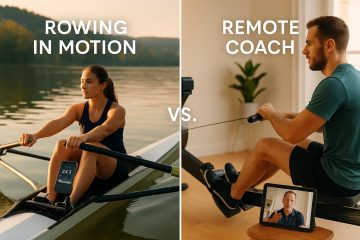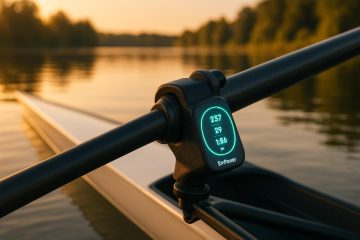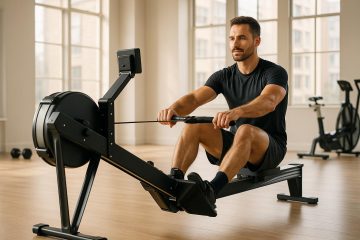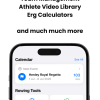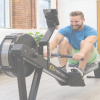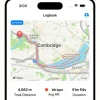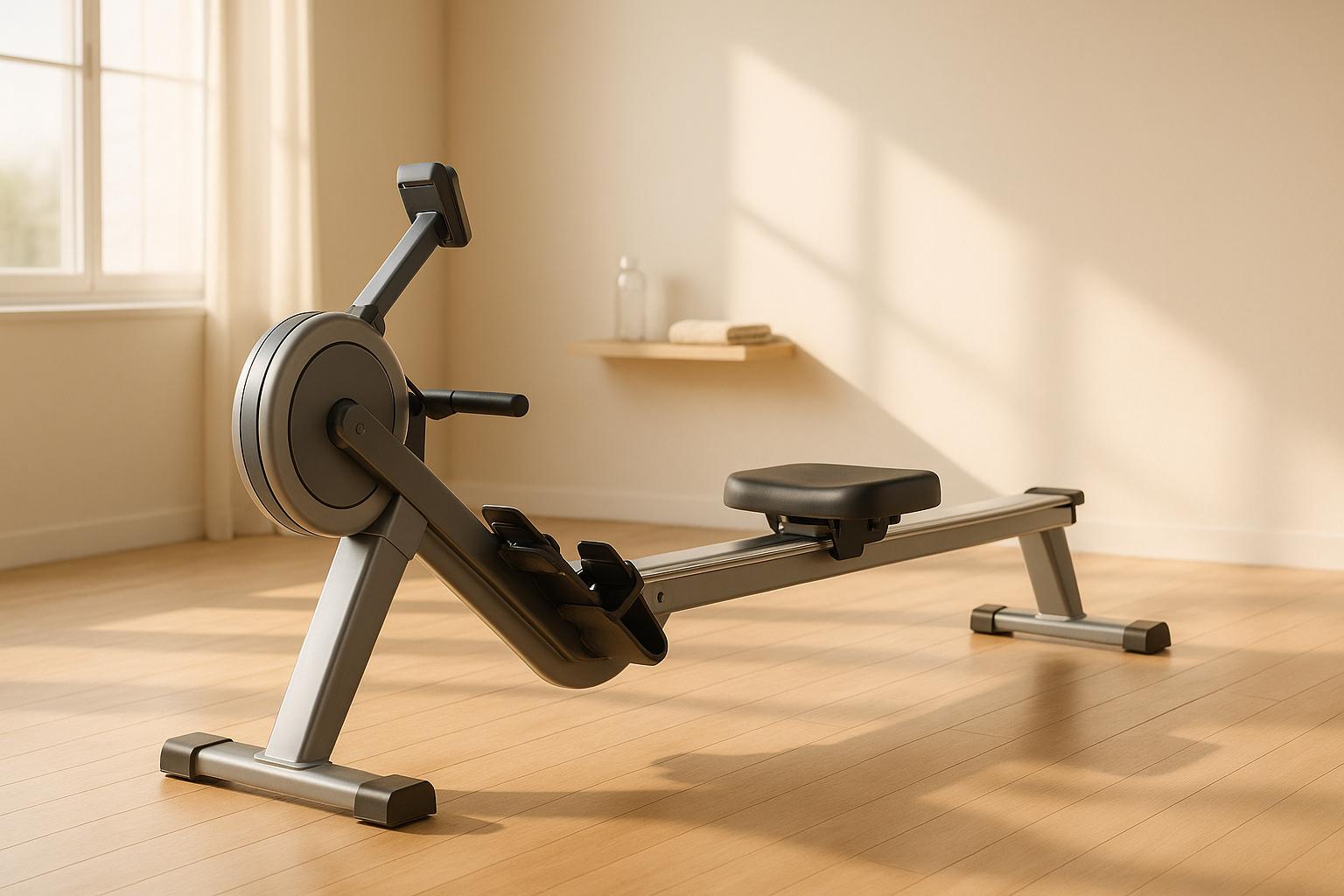
Beginner’s Guide: How to Choose Your First Rowing Machine
Looking for your first rowing machine? Here’s what you need to know:
Choosing the right rowing machine can make or break your fitness journey. The perfect machine fits your space, aligns with your goals, and keeps you motivated. Here’s a quick breakdown:
- Types of Rowers:
- Magnetic: Quiet, compact, beginner-friendly.
- Air: Mimics real rowing, great for athletes, but noisy.
- Water: Realistic feel, soothing sound, higher maintenance.
- Hydraulic: Budget-friendly, compact, less smooth motion.
- Key Factors:
- Budget: Prices range from under $250 (basic models) to $1,000+ (premium features).
- Space: Measure carefully – most rowers need 7-9 feet of length. Foldable options are ideal for small spaces.
- Goals: Weight loss? Cardio? Realistic rowing experience? Match the machine to your needs.
- Quick Tip: Magnetic rowers are quiet and low-maintenance, while air and water rowers offer a more authentic feel.
Quick Comparison Table:
| Type | Best For | Noise Level | Space Required | Price Range | Maintenance |
|---|---|---|---|---|---|
| Magnetic | Quiet home use, beginners | Very low | Compact | $250–$1,000 | Low |
| Air | Athletes, real rowing feel | High | Large | $500–$1,000+ | Moderate |
| Water | Realistic experience | Moderate | Large | $1,000+ | High |
| Hydraulic | Budget, small spaces | Low | Very compact | <$250 | Low |
Pro Tip: Test different machines before buying to find what feels right for you. Ready to dive in? Let’s explore the details.
BUYING A ROWING MACHINE? (I Compare the Benefits of All 4 Types)
4 Types of Rowing Machines: How They Work and What Makes Them Different
Choosing the right rowing machine for your home gym starts with understanding how the different types work. Each machine uses a unique resistance system, creating distinct workout experiences. Let’s break down the four main types to help you decide which one fits your needs.
Magnetic Resistance Machines
Magnetic rowing machines are known for their smooth and quiet operation, making them a go-to choice for apartment dwellers or anyone who values a noise-free workout. Thanks to their compact design, they’re easy to store and ideal for smaller spaces. The resistance is adjustable and stays consistent throughout each stroke, but it doesn’t quite replicate the sensation of rowing on water. As Sarah Fuhrmann, certified indoor rowing coach and CEO of UCanRow2, puts it:
"Resistance [in magnetic rowers] is constant, which is why it feels less like on-water rowing than air- or water-based machines."
These machines are beginner-friendly, affordable, and require minimal upkeep, making them a practical option for those just starting out.
Air Resistance Machines
Air rowers use a flywheel to create resistance that adjusts naturally to your effort – the harder you row, the more resistance you experience. This dynamic system closely mimics the feel of rowing on water, which is why these machines are a favorite among athletes and fitness enthusiasts. You’ll often find them in commercial gyms and CrossFit centers due to their durability and performance.
However, air rowers can be noisy and need a fair amount of space, so they might not be the best fit for everyone.
Water Resistance Machines
Water rowing machines offer one of the most realistic indoor rowing experiences. They use water and paddles to create resistance, which increases naturally as you row harder. This setup closely replicates the sensation of gliding through water. Certified personal trainer Eryn Barber highlights this feature:
"This type of rower mimics the sound and feeling of rowing on water. They are ideal for anyone who wants a smooth feel and realistic rowing experience."
Many users find the gentle sound of water soothing, but these machines come with a higher price tag, need more space, and require periodic maintenance to keep them in top shape.
Hydraulic Resistance Machines
Hydraulic rowers use pistons to provide resistance, making them the most budget-friendly and space-saving option. Their compact size is perfect for small apartments, and they operate quietly, requiring little maintenance. However, the rowing motion isn’t as smooth or natural compared to other types, and the resistance can feel uneven.
If you’re tight on space or working with a limited budget, a hydraulic rower might be your best bet.
| Resistance Type | Best For | Noise Level | Space Required | Price Range | Maintenance |
|---|---|---|---|---|---|
| Magnetic | Quiet home use, beginners | Very quiet | Compact | Mid-range | Low |
| Air | Athletes, authentic feel | Loud | Large | Mid-range | Moderate |
| Water | Realistic experience | Moderate | Large | High | High |
| Hydraulic | Budget-conscious, small spaces | Quiet | Very compact | Low | Low |
Ultimately, the best rowing machine for you depends on your fitness goals, available space, and budget. Each type offers its own set of advantages, so consider what matters most to you before making a decision.
What to Consider Before Buying Your First Rowing Machine
Now that you’re familiar with the various types of rowing machines, it’s time to focus on three key factors to guide your purchase: budget, space, and fitness goals.
Budget and Price Range
Setting a clear budget is the smartest first step when shopping for a rowing machine. You’ll find quality options across a wide range of prices, so there’s something for almost everyone.
Here’s a breakdown of common price categories:
- Lo-Cost (under $250): Basic hydraulic models, great for beginners on a tight budget.
- Budget ($250–$500): Machines with magnetic or air resistance, offering essential features like simple monitors and comfortable seating.
- Mid-Range ($500–$1,000): Advanced rowers with features like heart rate programs and PC connectivity.
- Top Range (over $1,000): Premium models with advanced connectivity and high-quality materials.
Certified personal trainer Amanda Capritto points out:
"The ‘sweet spot’ is around $1,000, offering high-quality rowers with some features but lacking expensive additions like full-color LED digital monitors."
When comparing options, prioritize a sturdy frame, ergonomic design, and essential monitoring features. A user of the Sunny Health & Fitness SF-RW5515 Magnetic Rowing Machine (priced around $200) shared:
"Better quality than I expected. I highly recommend for beginners and moderate users."
If you’re eyeing smart rowing machines with touchscreens and streaming capabilities, keep in mind they often come with higher price tags and monthly subscription fees to unlock all features.
Once your budget is set, the next step is ensuring the machine fits your available space.
Space and Storage Requirements
Before making a purchase, measure your space carefully to avoid any surprises. Rowing machines typically range from 7 to 9 feet in length and 2 to 3 feet in width, so you’ll need additional clearance for safe operation. Allow at least 2 feet of space on each side and 4 feet behind the machine. For high-intensity workouts, plan for about 12 inches of clearance in front and behind, as machines can shift slightly during use. Testing the rowing motion in your chosen area can also confirm proper clearance.
For smaller spaces, consider these storage-friendly options:
- Foldable Models: Compact designs that can be stored away when not in use.
- Vertical Storage: Saves space and minimizes the risk of damage. For example, the Hydrow Wave measures 82" H x 30" W x 26.5" L when stored upright, compared to 80" L x 19" W x 43" H during use.
Adding a floor mat can protect your flooring and provide extra grip for the machine. Whether you’re setting up in a living room, basement, or dedicated workout area, proper measurements ensure a safe and comfortable setup.
Fitness Goals and Noise Preferences
Your fitness goals and living situation should also play a big role in your decision. Rowing is a versatile workout that benefits nearly everyone. As Amanda Capritto notes:
"As an exercise professional, I think everyone can benefit from rowing as a form of exercise, [especially] people who need a low-impact form of cardio."
Different types of rowers cater to specific needs:
- For weight loss and general cardio: Magnetic rowers are quiet and provide consistent resistance, making them perfect for shared living spaces.
- For athletic training and HIIT workouts: Air and water rowers are ideal for high-intensity training, with air rowers offering real-time resistance adjustments.
- For a realistic rowing experience: Water rowers replicate the feel and sound of rowing on water, offering a more authentic experience.
Noise levels are another critical factor, especially in apartments or shared spaces. Here’s a quick comparison:
| Resistance Type | Noise Level | Best Environment |
|---|---|---|
| Magnetic | Very low | Apartments, early morning/late night workouts |
| Hydraulic | Low | Small spaces, noise-sensitive areas |
| Water | Moderate | Home gyms, dedicated workout rooms |
| Air | High | Basements, garages, soundproofed areas |
Merachfit‘s Head Product Engineer advises:
"If noise is your primary concern, a quality magnetic rower is your best option. Just be sure to invest in a model with sufficient resistance range to support your long-term progression. Budget magnetic rowers under $300 often disappoint serious users within months."
When choosing, think about your household schedule, living arrangements, and workout habits. The ideal rowing machine balances your fitness goals with practical considerations like budget, space, and noise tolerance.
Next, let’s dive into the key features that first-time buyers should prioritize.
Important Features for First-Time Buyers
When selecting your first rowing machine, it’s essential to focus on features that enhance both performance and comfort. This ensures your choice aligns with your fitness goals and fits seamlessly into your lifestyle.
Key areas to keep in mind:
Display and Tracking Metrics
A clear and detailed display is a must-have for tracking your progress. Look for monitors that provide core metrics like split time (pace per 500 meters), strokes per minute (SPM), distance, watts (power output), and calories burned. Some advanced displays even come equipped with extras like Bluetooth connectivity for heart rate tracking, progress charts, or a "pace boat" race simulation to make your workouts more interactive and motivating. These metrics not only help you stay on track but also allow you to adjust your training for better results.
Comfort and Ergonomics
Comfort plays a huge role in sticking to your workout routine and avoiding unnecessary strain or injuries. Since rowing engages up to 85% of your muscles, it’s crucial to choose a machine with features that prioritize ergonomics. Look for a contoured seat with good cushioning, handlebars that encourage a neutral wrist position, and adjustable footrests to accommodate various foot sizes. A well-designed, ergonomic machine can make your workouts more enjoyable and help you stay consistent.
Easy Assembly and Maintenance
Ease of setup and maintenance can significantly impact your overall experience. Many rowing machines are designed with user-friendly assembly features, such as transport wheels for convenient storage and movement. Maintenance requirements also differ depending on the resistance type – air resistance machines, for example, generally need less upkeep compared to water resistance models. The Concept2 RowErg is a standout option in this regard, known for its durability and low maintenance. Its design even lets you separate it into two pieces for easy storage without needing tools. When deciding on a model, think about how assembly and maintenance will affect your long-term enjoyment and use of the machine.
Top Rowing Machine Picks for Beginners
Choosing the right rowing machine as a beginner doesn’t have to feel daunting. Depending on your budget, available space, and workout goals, here are some standout options to get you started. Each pick aligns with different needs, helping you find the perfect fit for your rowing journey.
Best Overall: Hydrow Wave
The Hydrow Wave is a fantastic all-around option for beginners, priced at $1,815. While it costs more than basic models, it offers a highly realistic rowing experience with a sturdy build and excellent stability. Its sleek design makes it easy to integrate into your home, making it a great long-term choice as you develop your rowing skills.
Best for Small Spaces: Folding Rowing Machines
If space is tight, folding rowing machines are a practical solution. These compact models deliver solid performance without taking up too much room.
- Sunny Health & Fitness SF-RW5801: At just $219.99, this model offers 16 levels of magnetic resistance and folds upright for easy storage. Perfect for apartments or shared living spaces.
- Echelon Row-S: With a hinging rail system that reduces its footprint to just 5.83 square feet, this premium option is priced at $1,899.99. It includes a rotating monitor and scenic workout features.
- Sunny Health & Fitness SF-RW5639SMART: Priced at $249.99, this compact rower comes with transport wheels and provides effective resistance training.
Best Premium Experience: Water and Air Rowers
For those seeking a more immersive and authentic workout, water and air rowers stand out with their premium features.
Water rowers, like the WaterRower Natural, deliver an incredibly lifelike experience. The smooth resistance and calming sound of flowing water create a serene workout atmosphere. As Michael Chong, Head Product Engineer at Merachfit, puts it:
"Water rowers offer the most aesthetically pleasing and authentic rowing experience. They’re particularly appealing to those who view their workout as a mindfulness practice and want equipment that doubles as a design piece. The natural wood construction of premium models allows them to blend into home environments beautifully."
Air rowers are another excellent choice, with the Concept2 RowErg being a standout option. Priced at $990, it’s known for its durability and consistent performance. With a perfect 5/5 rating for reliability, it accommodates users of various heights. Its design also allows it to break down into two pieces for storage or hang on a wall, making it a practical yet high-performing option.
Both water and air rowers engage multiple major muscle groups while providing excellent cardiovascular benefits, making them ideal for beginners looking for a top-tier rowing experience.
Making the Right Choice for Your Needs
Choosing your first rowing machine means taking a good look at your fitness goals, available space, and budget. The trick is finding the right balance so you end up with a machine you’ll actually use regularly.
Start by identifying what you want to achieve. As Hydrow explains, "Honing in on your personal fitness goals can help you determine whether a rowing machine is the right pick for your home gym". If you’re aiming for high-intensity workouts that mimic the feel of outdoor rowing, air or water rowers might be your best bet. On the other hand, if you’re looking for quieter operation and general fitness improvement, magnetic or hydraulic rowers could be a better fit. From there, think about practical concerns like space and noise, as these can heavily influence your decision.
Noise and space limitations are especially important if you live in an apartment or share walls with neighbors. In these cases, the nearly silent operation of a magnetic rower might be a lifesaver. But if you have a dedicated workout area and enjoy the natural sound of water resistance, a water rower could make your sessions feel more immersive.
It’s also smart to think long-term. Don’t just go for the cheapest option – choose a machine that offers durability and functionality. A key feature to look for is a monorail that’s long enough to accommodate your full leg extension for a proper rowing stroke.
Before committing to a purchase, try different models if you can. Testing out various resistance types at a gym or fitness store can help you avoid buyer’s remorse. For example, you might find that you enjoy the dynamic resistance of an air rower more than the steady pull of a magnetic system. This hands-on approach ensures the machine will work for both your current setup and your evolving fitness journey.
Comfort is another factor that can’t be overlooked. Features like a well-padded seat, ergonomic handle, and adjustable footplates can make a huge difference, especially during longer workouts. The more comfortable you are, the more likely you are to stick with your routine.
Lastly, think about how a rowing machine fits into your overall fitness lifestyle. If you love guided workouts and tracking your progress, a rower with interactive features might be worth the extra cost. But if you prefer simple, no-frills workouts, a basic but sturdy machine could be all you need.
Ultimately, the best rowing machine is one that aligns with your goals, fits your space, and keeps you motivated to use it regularly. Take the time to weigh your options thoughtfully, and you’ll end up with a machine that supports your fitness journey for years to come.
FAQs
What’s the difference between magnetic and air rowing machines, and which one is right for me?
The main distinction between magnetic and air rowing machines lies in how they generate resistance and the kind of workout experience they deliver.
Air rowing machines rely on a fan to create resistance. The harder you row, the more resistance you feel, making them perfect for high-intensity workouts or interval training. The downside? They can be loud due to the fan mechanism, which might not be ideal for everyone.
Magnetic rowing machines, in contrast, use magnets to offer a smooth and steady resistance. They’re significantly quieter than air rowers and let you manually adjust the resistance level. This makes them a great option for steady-paced cardio or for those who value a quieter workout space. Unlike air rowers, the resistance remains constant regardless of your rowing speed, which can be especially beneficial for beginners or anyone focused on controlled movements.
Choosing between the two comes down to your fitness goals, workout style, and how much noise you’re comfortable with during exercise.
How do I choose the right type of rowing machine for my fitness goals and space at home?
Choosing a rowing machine comes down to what you want to achieve and how much space you have at home. If you’re looking for high-intensity workouts that adjust to your effort, an air rower could be the way to go. Its resistance increases with your rowing speed, giving you a dynamic workout. That said, air rowers tend to be larger and can get pretty noisy, which might not be ideal for smaller spaces or shared living environments.
For those with limited space, hydraulic rowers are a solid option. They’re quieter, more compact, and easy to store, making them great for beginners or casual users. On the other hand, if you’re after a rowing machine that feels like you’re gliding across water, a water rower might be your best bet. These machines mimic the sensation and sound of real rowing but typically take up more space and need a bit more upkeep.
The key is to pick a machine that aligns with your fitness goals and fits comfortably in your workout area.
What maintenance should I consider when deciding between a water or hydraulic rowing machine?
When deciding between water and hydraulic rowing machines, one key factor to consider is how much maintenance each type needs.
Water rowing machines demand consistent upkeep to keep the tank and water in good condition. It’s a good idea to use distilled water and add purification tablets every few months to stop algae from growing. After each session, wipe down the machine to keep it clean, and make sure to inspect the tank for leaks or any loose parts.
Hydraulic rowing machines, on the other hand, need periodic lubrication to keep the moving parts, like the hydraulic cylinders, running smoothly. It’s also smart to check the hydraulic lines monthly for signs of wear or leaks. Regular cleaning helps prevent dust buildup and corrosion, which can affect performance over time.
In short, water rowers require more attention to their tank and water system, while hydraulic rowers focus on lubrication and monitoring for leaks.


